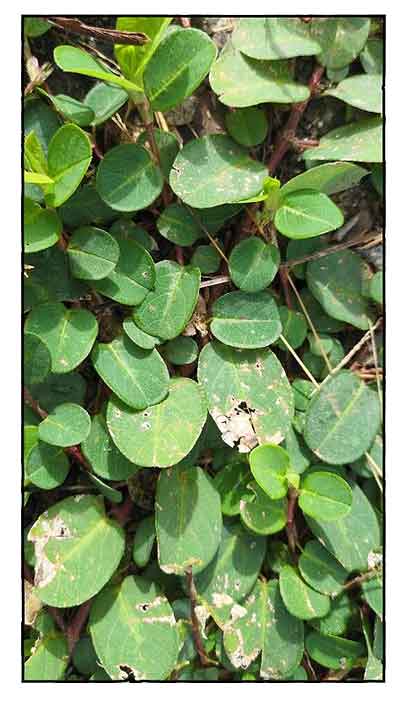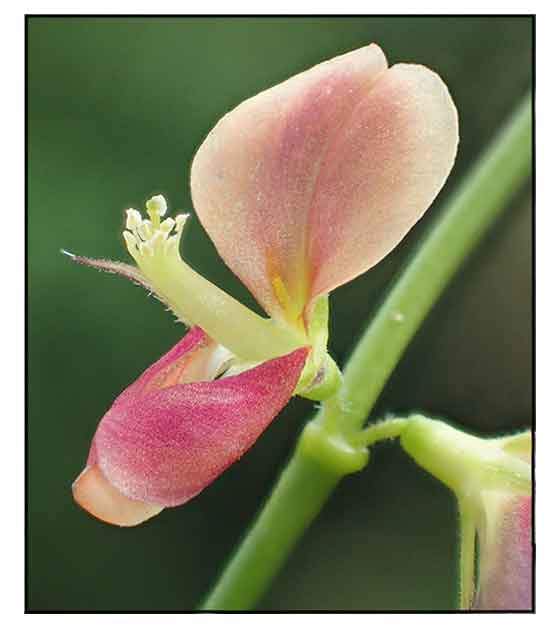 Gen info Gen info
- The family Fabaceae consists of about 20,000 species spread in 650 genera.
- Alysicarpus is a genus of flowering plant in the legume family, Fabaceae, distributed in tropical and subtropical regions of Africa, Asia, and Australia. Species are generally known as moneyworts.
Botany
• Herbs, annual. Stem erect or spreading, sometimes woody at base, 10-60 cm tall, puberulent, glabrescent. Leaflets usually dimorphic, elliptic or oblong in lower part and lanceolate in upper part, 1-10 × 0.6-3 cm. Inflorescences terminal or leaf-opposed, laxly flowered; bracteoles absent. Pedicel 1-2 mm, with spreading hooked hairs. Calyx glumaceous, scarious, persistent, 4-lobed, with minute spreading hooked hairs and sparsely ciliate straight hairs; lobes not imbricate, subequal, narrowly triangular-ovate, 3-4 mm, ciliate, apex acuminate. Petals pink or reddish purple, subequal with calyx at anthesis. Legume (1-)4-6(-8)-jointed, (0.5-)1.5-2.2 cm × 1.8-2.3 mm, indehiscent, with dense minute hooked hairs, mostly without septa inside and with ridges at joint. (Flora of China)
• Annual herb, erect-spreading, 20-60 cm tall. Stem pubescent. Leaf unifoliolate, leaflets 1-10 cm long, 0.6-3 cm broad, elliptic or oblong to narrowly lanceolate, acute to emarginate, mucronate, puberulous, petiole 2-8 mm long, petiolule 1-1.5 mm long, stipules 0.5-2.0 cm long. Inflorescence terminal or leaf-opposed or paniculate, peduncle 3-4 cm long, rachis 3-11 cm long, pedicel 1-2 mm long. Bracts 4-5 mm long. Calyx 4.5-6 mm long, pubescent, teeth 3-4 mm long. Corolla orange-buff to pink or reddish violet rarely whitish, Vexillum 4-6 mm long. Fruit 1.8-2.5 cm long, 2-8-seeded, not constricted, each 1-seeded part 2.5-4 mm long, 2.0-2.5 mm broad, puberulous. (Flora of Pakistan) (Missouri Botanical Garden)
 Distribution Distribution
- Native to the
Philippines. (1)
- Per Leonardo Co, native. Other sources list it as naturalized.
- Distribution (Per Co's Digital Flora Database):
Afghanistan, Africa, Australia, Bismarck Arch, Borneo, China, India, Indian Ocean, Java, Malay Peninsula, Middle East, New Guinea, Pacific Ocean, Pakistan, Philippines, Ryukyu Isls, Singapore, Solomon Isls, Sumatra, Taiwan. (1)
- Also native to Afghanistan, Angola, Bangladesh, Benin, Burkina, Cameroon, Cape Verde, Central African Republic, Chad, Comoros, DR Congo, Ethiopia, Gabon, Gambia, Ghana, Guinea, Guinea-Bissau, India, Ivory Coast, Kenya, Madagascar, Malawi, Mali, Mauritania, Mozambique, Nansei-shoto, Nepal, Niger, Nigeria, Oman, Pakistan, Senegal, Sudan-South Sudan, Tanzania, Togo, West Himalaya, Zambia, Zimbabwe. (POWO) (2)
Constituents
- Study of stem bark isolated three carbazole alkaloids identified as mohanimbine (1), koenimbine (2) and koenidine (3) along with quercetin 3-O-glucoside (4), kaempferol 7-O-glucoside (5), orientin (6), apigenin (7), quercetin (8), plumbagin (9) and stigmasterol (10). (see study below) (8)
- Preliminary phytochemical screening revealed presence of steroids, triterpenes, and cardiac glycosides in the petroleum ether fraction, while cardiac glycosides, saponins, steroids, triterpenes, and flavonoids were present in the methanolic extract. Thin layer chromatography yielded two compounds coded D7 and E17. D7 was characterized as a glycosidic flavone (3,5-dihydroxy-4¹-methoxy-7-O-β- glycosyl flavone,(C19H22O10) and E17 was characterized as 3 β –cholest-5-ene-3-diol. (see study below) (9)
- Study for various elements in sheets, stems, and pods yielded in g/100g: Protein 17.00, ND, ND;
ß-carotene 2.49, 0.09, 0.17; vitamin B ND, 21.17, 65.38; iodide 0.1, 0.15, 0.27; vitamin C 19.00, 375, 63.00; iron 8.50, 98.25,839.50;calcium 0.84, 9.94, 12.42. (12)
Properties
- Studies have suggested larvicidal, antiplasmodial, antibacterial, antifungal, antinociceptive, CNS stimulant, physical performance-enhancing properties.
Parts used
Leaves, roots.
 Uses Uses
Edibility
- Herbal tea used as energy booster.
Folkloric
- No reported folkloric medicinal use in the Philippines.
- In northern Nigeria, used as wound healing medicine and stimulant. Tea is prepared from the plant alone or along with other ingredients to increase endurance, and help stay alert and active. (4)
- Leaf sap, juice and root decoction used in jaundice and to relieve cough. Root decoction used for treatment of coli, as tonic, and for healing of wounds. Whole plant used for treatment of fever and ringworm infections, wound healing, acute and chronic bleeding hemorrhoids. Also used as stimulant in birth control. (5)
Others
- Fodder: It is a weed in millet crops but exploited as a fodder. An attempt was made in Burkina
Fasso to sow the plant to enhance the value of natural pastures and it proved to settle efficiently after sowing (Kiema et al., 2006) (7) Provides a protein-rich fodder and palatable feed for livestock grazing in rangelands. N and P concentrations are 2.9-4.1% and 0.18% respectively. In vitro digestibility of dry matter in 690% during the wet season. In Niger, it is a valuable component of vegetation collected and traded as fodder. (11)
Studies
• Antinociceptive / Aerial Parts: Study of evaluated the antinociceptive effects of hydroethanolic extract of aerial parts of A. ovalifolius (HEAo) in mice and rats using acetic acid-induced abdominal writhing, formalin induced pain and tail immersion test in mice, and carrageenan-induced pain in rats. Doses of 100-400 mg/kg significantly and dose-dependently decreased the number of abdominal writhing in mice, decreased pain reaction in both phases of formalin induce algesia, and amelioration of carrageenan induced hyperalgesic in rats. Reaction time in tail immersion test was increase. Results suggest the presence of phytoconstituents acting on peripheral and centrally mediated pain receptors for the antinociceptive actions. (4)
• Acute Toxicity Study / Aerial Parts: Study evaluated the acute toxicity of aqueous extract of A. ovalifolius in mice using Lorke's method. The extract did not produce any mortality at doses administered, with no changes in organ weight, no morphological alterations on macroscopic and histologic assessment of systemic organs. The D50 was estimated to be greater than 5 g/kg. The aqueous extract can be considered of low toxic potential on acute oral administration. (6)
• Larvicidal / Antiplasmodial / Antimicrobial / Stem Bark: Study of stem bark isolated three carbazole alkaloids identified as mohanimbine (1), koenimbine (2) and koenidine (3) along with quercetin 3-O-glucoside (4), kaempferol 7-O-glucoside (5), orientin (6), apigenin (7), quercetin (8), plumbagin (9) and stigmasterol (10). Compound 3 showed strong activity against chloroquine-sensitive strain I (D6) and multi-drug resistant Indochina I (W2) of Plasmodium falciparum with IC50s of 63.07 and 54.19 mg/mL, respectively. Compound 1 exhibited moderate larvicidal activity against Anopheles gambiae larvae and antimicrobial activities against Candida albicans and Gm(+) Staphylococcus aureus. (8)
• Central Nervous System Stimulant Activity: Defatted dried powder of aerial parts was extracted with methanol and partitioned with petroleum ether, ethyl acetate, and n-butanol. Thin layer chromatography of n-butanol fraction yielded two compounds, D7 and E17. Study evaluated the extract for central nervous system stimulant activity using drug (diazepam) induced-sleep in mice and hole-board experiment. Diazepam induced-sleep showed decrease onset of sleep, while hole-board test suggested constituents with CNS stimulant activity as evidenced by exploratory behavior in mice. (see constituents above) (9)
• Physical Performance Enhancing / Aerial Parts: Study evaluated the effects of aqueous extract of aerial parts of A. ovalifolius (AO) on physical performance in Swiss albino mice. Extract (100 - 400 mg/kg) produced significant (p<0.05) dose-dependent increase in swimming time; increased time spent on rotarod and increased duration in four-limb hanging test. No effect was observed in endurance to hypoxic condition. Dizepam-induced sleeping time was significantly decreased in AO-treated animals. Observations were comparable to caffeine (15 mg/kg). The aqueous extract increased physical performance in mice by enhancing endurance, muscle strength and coordination. (10)
Availability
- Wild-crafted. |

![]()



 Gen info
Gen info

